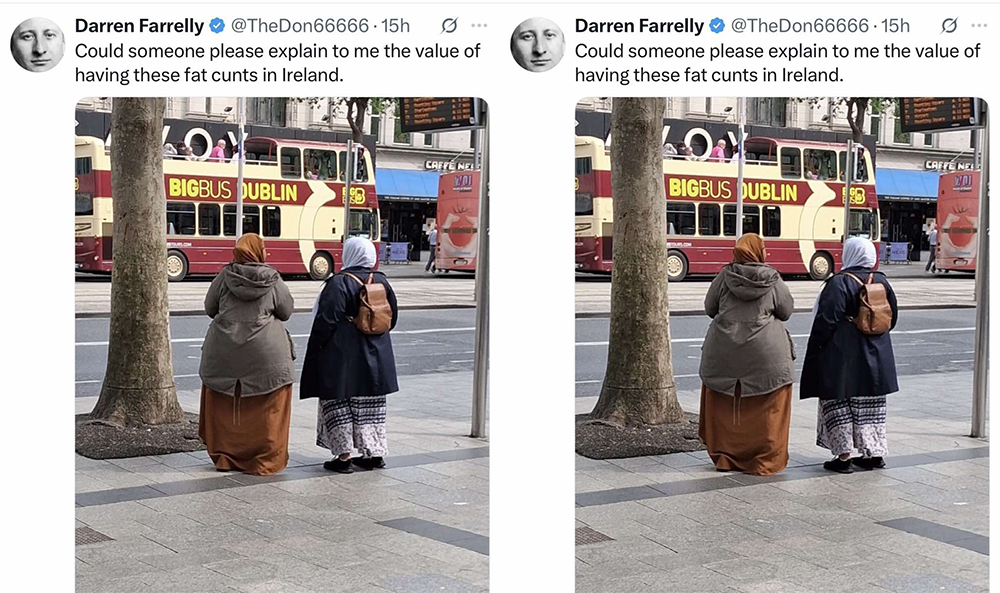Who Belongs in Ireland? Unpacking the Immigration Debate Through a Viral X Post
4/29/20253 min read


Who Belongs in Ireland? Unpacking the Immigration Debate Through a Viral X Post
Introduction: A Snapshot That Sparked Outrage
On April 28, 2025, a photo posted on X by user @TheDon66666 went viral for all the wrong reasons. The image shows two women standing on a Dublin sidewalk near a Big Bus Tours double-decker, accompanied by a derogatory caption: "Could someone please explain to me the value of having these fat cunts in Ireland." The post ignited a firestorm of responses, exposing deep-seated tensions about immigration, cultural identity, and belonging in Ireland. Let’s dive into what this moment reveals about the broader immigration debate—and what it means for Ireland’s future.
A Changing Ireland: From Emigration to Immigration
Historically, Ireland was a nation of emigrants, with millions leaving during the Great Famine and beyond. But since the 1990s, the script has flipped. A 2022 census reported 83,300 Muslims living in Ireland—a 29.1% increase from 2016—alongside growing Orthodox and other minority communities (Wikipedia, 2025). By 2006, immigrants made up 10% of the population, a stark contrast to the more homogenous Ireland of decades past (migrant-integration.ec.europa.eu). This rapid demographic shift has brought cultural diversity but also challenges, as Ireland grapples with integration, tolerance, and what it means to be Irish in the 21st century.
The X Post: A Mirror to Anti-Immigrant Sentiment
The photo in the X post captures a mundane moment: two women, one with a backpack, standing near a tree in Dublin. But the caption and replies reveal a darker undercurrent. @Mangemongen, replying from Sweden, laments similar struggles there, claiming immigrants "live here for 20 years and still not be able to speak Swedish, sucking up millions in government aid." @C_O_M_F_Y_F_R_E_N goes further, stating, "If all browns left, Ireland would be a much better place." These comments echo a broader European backlash against immigration, seen in Sweden’s rising crime rates and cultural clashes (RedState, 2025). In Ireland, the sentiment isn’t new—anti-Irish sentiment, or Hibernophobia, has historical roots, often tied to religious and cultural differences (Wikipedia, 2025). Today, that same lens of "othering" is turned toward new arrivals.
The Value Debate: What Does “Contribution” Mean?
At the heart of the X thread is a question of "value." What do immigrants bring to Ireland, and who gets to decide? Economically, immigrants often fill labor shortages—think of the healthcare workers, tech professionals, and service industry employees who keep Ireland running. Culturally, they enrich the tapestry of a nation once known for its insularity, as seen in initiatives like the Migrant Integration Strategy’s focus on arts and culture programs (Taylor & Francis, 2025). Yet, the perception of burden persists. High-profile cases of welfare dependency or crime among immigrant communities fuel narratives like those in the X thread, even if they don’t tell the whole story. In Sweden, for instance, poorly integrated neighborhoods have become "incubators for crime," a cautionary tale for Ireland (GIS Reports, 2024).
The Other Side: Humanity Over StereotypesNot everyone on X agreed with@TheDon66666. User@reggie_stratton called out the "disgusting attitude," arguing for compassion over dehumanization. This pushback highlights a key tension: how do we balance legitimate concerns about integration with the basic humanity of those who’ve made Ireland their home? The women in the photo aren’t statistics—they’re individuals with stories, dreams, and struggles. Reducing them to slurs or scapegoats ignores the complexity of their lives and the systemic challenges of integration, like language barriers or access to education.
Ireland at a Crossroads
Ireland stands at a crossroads. Will it embrace its newfound diversity as a strength, as seen in policies promoting cultural rights (Taylor & Francis, 2025)? Or will it succumb to fear and division, as the X post suggests? The government’s Migrant Integration Strategy aims to foster inclusion through arts, civic participation, and education, but public sentiment lags behind. The viral photo reminds us that integration isn’t just a policy issue—it’s a deeply personal one, shaped by everyday interactions on the streets of Dublin and beyond.
Conclusion: A Call to Reflect
The X post by @TheDon66666 isn’t just a fleeting controversy—it’s a window into Ireland’s soul. As the nation navigates its multicultural future, moments like these force us to confront uncomfortable truths about belonging, value, and identity. So, I’ll leave you with a few questions to ponder:
What does it mean to be "valuable" to a society, and who gets to define it?
How can Ireland balance cultural preservation with the realities of immigration?
Have you ever witnessed or experienced "othering" in your own community—how did it make you feel?
Let’s keep the conversation going. Share your thoughts in the comments below.
hello@boncopia.com
+13286036419
© 2025. All rights reserved.